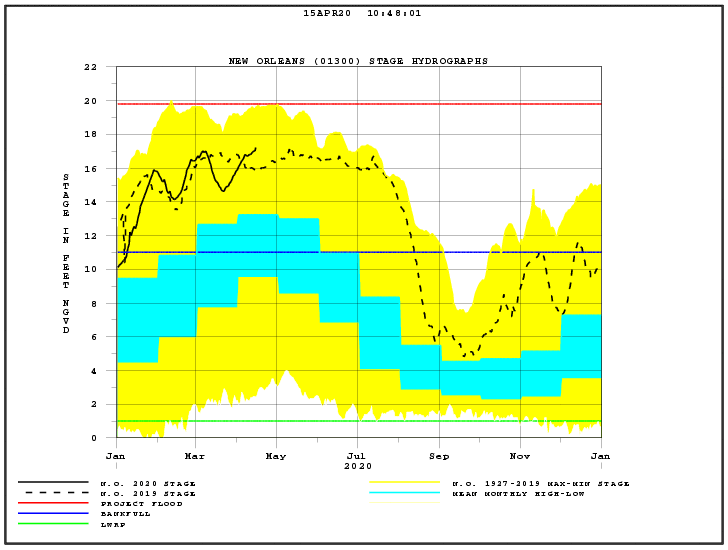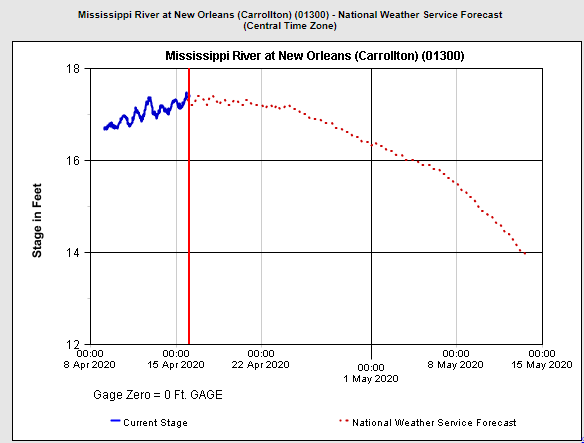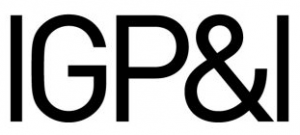High water season in the Mississippi River - be prepared

High water season in the Mississippi River - be prepared
Published 15 April 2020
The changing conditions with currents and shoaling during the period of high water can lead to loss of, fouled or entangled anchors, groundings and broken moorings.
The high water season in the Mississippi River is generally said to be between December and May with the highest water levels usually occurring between February and May. This four-month period is often incorrectly thought to be the only highwater season. However, episodes of high water, increased currents and shoaling can be experienced at many times of the year and are known to have sometimes occurred from January to August. Long term forecasts for the area may be inaccurate as huge land areas drain into the river and heavy precipitation and snow melt in Spring may lead to rapid changes in the water levels.During 2019 the Mississippi River saw high water levels until August. The water levels so far in 2020 appear to follow a similar pattern to 2019. Gard saw a number of incidents involving loss of anchors, entangled anchors, groundings and broken moorings in the Mississippi River area during the high-water period last year.High water, strong currents and shoaling can cause delays and result in extra costs as a result of damage to anchors and mooring equipment, draft and navigation restrictions, extra tugs and pilot assistance, and difficult mooring and anchoring conditions. There may be considerable additional expenses if extra tugs and pilot assistance are required.Recommendations - be proactive
Check with local agents, the USCG Marine safety Information Bulletins (MSIBs) and the US National Weather Service for the latest information on river conditions, forecasts, and restrictions in place if any. Typical restrictions may include mandatory pilotage and tugs for deep draft vessels at anchor, daylight navigation and mooring only, speed and one-way traffic restrictions, specific mooring and anchoring instructions and draft restrictions (which can change at short notice).
Anchor and mooring equipment must be in good working order and the crew should be familiar with the limitations of the equipment.
Anchoring in high water and high currents requires awareness and proper monitoring of anchor position, limitation of equipment, weather, current, wind and riverbed condition as well as local restrictions in place. Additional tug and pilot services may be necessary.
Loss of anchors is a common problem and will cause delays and incur extra costs as a result of compliance with USCG requirements as regards salvage, extra tugs and pilot services. Failure of anchors is typically caused by lack of maintenance of the anchor, chain and windlasses, or holding power exceeded due to dragging, exceeded load during heaving of fouled anchors, or current and weather conditions exceeding IACS design limitations.
Be aware of challenges with “open moor” anchorage, midstream buoy moorings and at berths with regards to anchor and mooring line arrangements. Also closely monitor anchors and mooring lines, yawing or fishtailing effects and be familiar with how to handle such situations. Request assistance from the terminal and consider tug and pilot assistance if necessary.
High water in the Mississippi River can be costly if ship operators are not prepared, with delays and damage to ship and equipment and the need to hire expensive assistance from tugs and pilot. Prudent and ample action is recommended should an incident develop as situations and costs may escalate quickly. We are grateful to our correspondents in New Orleans, Fernandes Maritime Consultants, and our correspondents, Independent Maritime Consulting, for the information received.

Mississippi_2020_1
Source: https://rivergages.mvr.usace.army.mil/WaterControl/Districts/MVN/car.gif

Mississippi_2020_2


